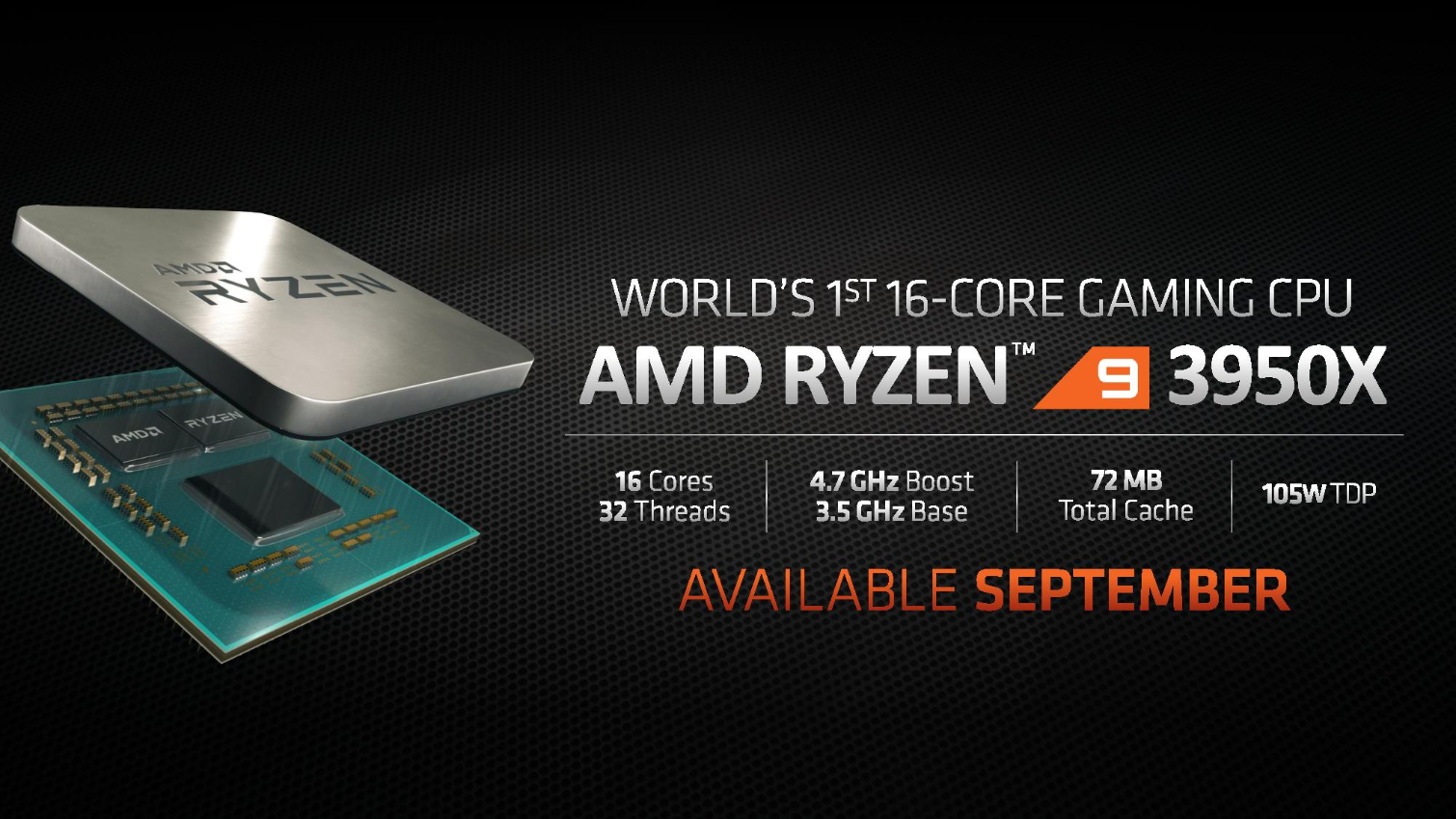AMD Reveals 16-Core, 4.7 GHz Boost Ryzen 9 3950X: $749, September Arrival
AMD CEO Lisa Su recently announced the company's new Ryzen 3000 series lineup at Computex 2019, but left out one official announcement for its Next Horizon Gaming Tech Day here in Los Angeles: The 16-core 32-thread Ryzen 9 3950X for $749. This new processor will land on shelves in September. We have more coverage of the Zen 2 microarchitecture and X570 chipset here.
The Ryzen 9 3950X easily outstrips Intel's halo eight-core sixteen-thread Core i9-9900K on the mainstream desktop, at least from a core count perspective, and with Intel's next-gen Comet Lake series appearing to top out at ten cores, it looks like AMD will hold that advantage for quite some time. AMD has already told us that the Ryzen 3000 series offers near-parity with Intel's gaming performance, and adding in the multi-threaded heft of eight more cores and sixteen more threads could allow it to steal the overall performance crown on the mainstream desktop, especially in heavily-threaded applications, like game streaming.
| Row 0 - Cell 0 | SEP (USD) | Cores / Threads | TDP (Watts) | Base Frequency (GHz) | Boost Frequency (GHz) | Total Cache (MB) | PCIe 4.0 Lanes (Processor / Chipset) | Launch Date |
| Ryzen 9 3950X | $? | 16 / 32 | 105W | 3.5 | 4.7 | 72 | 24 / 16 | September |
| Ryzen 9 3900X | $499 | 12 / 24 | 105W | 3.8 | 4.6 | 70 | 24 / 16 | July 7, 2019 |
| Ryzen 7 3800X | $399 | 8 / 16 | 105W | 3.9 | 4.5 | 36 | 24 / 16 | July 7, 2019 |
| Ryzen 7 3700X | $329 | 8 / 16 | 65W | 3.6 | 4.4 | 36 | 24 / 16 | July 7, 2019 |
| Ryzen 5 3600X | $249 | 6 / 12 | 95W | 3.8 | 4.4 | 35 | 24 / 16 | July 7, 2019 |
| Ryzen 5 3600 | $199 | 6 / 12 | 65W | 3.6 | 4.2 | 35 | 24 / 16 | July 7, 2019 |
The Ryzen 9 3950X comes with all the hallmarks of AMD's new architecture, including increased a big 15% IPC boost from the Zen 2 microarchitecture, but pairs that with a beastly 4.7 GHz boost frequency, the highest of the Ryzen 3000 series. Ryzen 9 3950X wields two chiplets fused together via AMD's Infinity Fabric and an I/O die. AMD hasn't specified how many of the 3950X's cores boost to 4.7 GHz, and if the chip adheres to the standard boosting behavior we see with current-gen mainstream Ryzen models the boost will apply to two cores. But we think there is the possibility it could have a quad core boost, just like the dual-die Threadripper models that boost on two cores per chiplet.
The 3950X's 3.5 GHz base frequency, while the lowest of the Ryzen 3000 family, is still might impressive: Intel's $1,700 16-core Core i9-9960X has a 3.1 GHz base and 4.4 GHz boost frequency, but you'll need an expensive HEDT setup to accommodate the chip.
AMD's 105W TDP rating is also an important consideration. AMD and Intel spec their TDP ratings differently, with the Intel measuring TDP at base clock frequencies, which often leads to an understated number due to much higher power consumption when the processor is in high power states, while AMD uses what is arguably a clearer metric that consists of full utilization of the chip in its dynamic range. In short, this means that the Ryzen 9 3950X should be an incredibly power-efficient chip, so cooling should be a relatively simple task and there should be plenty of headroom for overclocking the soldered chip.
Like the other Ryzen 3000 series models, the 3950X will fully support PCIe 4.0 and drop into socket AM4 motherboards, with a few caveats.
Aside from the boosted performance AMD has wrung from the 7nm process node, the company tailored the second-gen Zen architecture to provide a big boost to a number of common workloads, like gaming. AMD's doubling of the L3 cache per chiplet leads to a beastly 72MB of L3 cache for the 3950X. This larger cache boosts the amount of data the processor can hold close to the execution engines, thus defraying the latency impact of memory accesses. AMD also has a number of other improvements to boost gaming performance, but we'll have to hold those details until the NDA release later today.
Get Tom's Hardware's best news and in-depth reviews, straight to your inbox.

Paul Alcorn is the Editor-in-Chief for Tom's Hardware US. He also writes news and reviews on CPUs, storage, and enterprise hardware.

